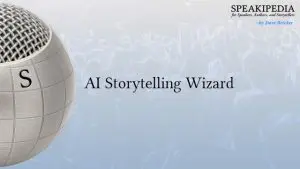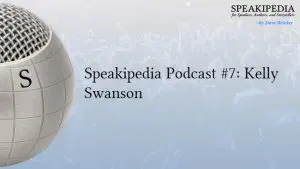by Dave Bricker
- Intro
- Setup
- Protagonist
- Transformation
- Conflict
- Steps
- Characters
- The Story
Introduction
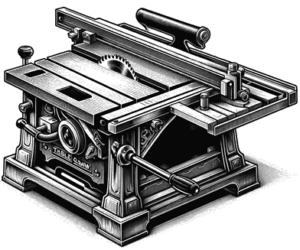 If you have zero carpentry skills and you purchase a table saw, you’ll likely lose a few fingers by the end of the day.
If you have zero carpentry skills and you purchase a table saw, you’ll likely lose a few fingers by the end of the day.
Artificial Intelligence works the same way. If you ask it to draw a “square circle,” it will blindly attempt to fulfill your wishes—and the result may not be kind to your eyes or your writing hand. Useful responses come from carefully-crafted prompts that tell the AI exactly what you want and what you don’t want.

What if we could combine Human Intelligence with Artificial Intelligence?
Say HI to AI!
The Speakipedia Story Wizard walks you through the process of story creation element-by-element. It will ask you to think about your characters and settings.
What kind of journey will you send them on?
What transformation are they seeking and how relevant are their goals to your audience’s?
Is your story designed to be read silently or spoken aloud?
Creating an authentic story requires careful thought. This wizard will not generate “square circles” or works of written eloquence with a click, but you’re the author! Use this tool to find inspiration and references, challenge your ideas and assumptions, and become a better (and more careful) literary carpenter.
Story Setup
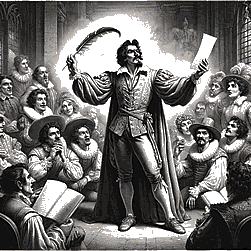 Describe your story’s tone, time period, location, and surrounding events. These elements set the style and scene of your story. The wizard will offer suggestions for stories you might want to reference, and stories you should be careful not to accidentally imitate.
Describe your story’s tone, time period, location, and surrounding events. These elements set the style and scene of your story. The wizard will offer suggestions for stories you might want to reference, and stories you should be careful not to accidentally imitate.
What is the tone of your story?
Serious, profound, romantic, humorous, fairy-tale-ish, etc.
What is the timeframe?
“1969” or “2145” or “The Middle Ages”
What is the geographical location?
“Woodstock, NY” or “Mars Colony IV” or “Europe”
Concurrent Historical Events
“Jimi Hendrix performs” or “The Martian Revolution” or “The plague”
Who?
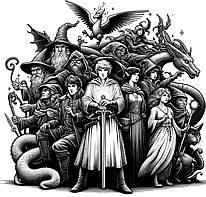 Stories are always about people. Your story can be about an individual, a group, an organization, citizens of a country, dentists, electricians, or members of a religion as long as you identify who the main character(s) are/is. We’ll refer to the person, people, or group as “the protagonist.”
Stories are always about people. Your story can be about an individual, a group, an organization, citizens of a country, dentists, electricians, or members of a religion as long as you identify who the main character(s) are/is. We’ll refer to the person, people, or group as “the protagonist.”
If the story is about you, choose “I” as the protagonist.
The protagonist could be “Joe,” “Members of the Danebury Metal Detecting Club,” or “Plumbers.”
If your protagonist is a group with a leader, you might choose “Ernest Shackleton and his crew.”
Who is the protagonist in your story?
Include their name and a brief description of their circumstances at the beginning of the story.
Harry is a smart-but-unappreciated child who has lived in a tiny room under the stairs at his aunt and uncle’s house since his parents were killed.
Peter is a sickly, orphaned teenager who lives in New York City with his aunt and uncle.
Captain John Smith is an experienced sea captain who plans to retire after one final cruise, a voyage on a new luxury ship called “Titanic.”
What is the protagonist’s backstory?
What was life like for them before the story? Did they fight in a war? Learn a trade? Experience a loss? Did they grow up in or adapt to a certain culture or community? Is there something about their background that they don’t remember or know yet?
Harry doesn’t know that his father was a wizard and his mother was a witch. Their friends at the wizarding school are waiting for him to come of age so they can teach him about his true potential.
After being bitten by a radioactive spider, Peter gains superhuman abilities, including strength, speed, agility, and the ability to cling to walls.
Edward John Smith, born 1850 was a British sea captain and naval officer. In 1880, he joined the White Star Line as an officer, beginning a long career in the British Merchant Navy. Smith went on to serve as the master of numerous White Star Line vessels. During the Second Boer War, he served in the Royal Naval Reserve, transporting British Imperial troops to the Cape Colony.
Normal
What does normal life look like for your protagonist before the catalyst event (we’ll get to that) sends them on their journey?
Harry mostly keeps to himself as he tries to avoid conflicts with his obnoxious aunt and uncle and their son. He is lonely and unhappy.
Though he is brilliant, Peter is bullied in high school and girls find him unattractive.
Captain Smith spends his life captaining merchant, military, and luxury ships from port to port.
Does your protagonist have an Achilles heel?
Superman can’t be around kryptonite. A person with diabetes must be careful with food. An alcoholic must resist temptation. An Achilles heel is not required but it can make your protagonist more interesting.
Harry has a scar on his forehead that hurts whenever enemies are near.
Ethyl chloride, the chemical that makes up bug spray, renders Peter’s spider-powers useless.
Captain Smith believes that after decades of successful passages, nothing can happen to his modern, sturdy ship.
Transformation
 The transformation offers a destination for the journey in the story. Too many stories fall apart because the author or speaker knows what the topic is, but they aren’t clear on the goals and lessons. Don’t create a story without a clear transformation in mind. That’s like going to the airport with no idea where you’ll fly.
The transformation offers a destination for the journey in the story. Too many stories fall apart because the author or speaker knows what the topic is, but they aren’t clear on the goals and lessons. Don’t create a story without a clear transformation in mind. That’s like going to the airport with no idea where you’ll fly.
An “authentic” transformation is a goal that’s tied to universal survival needs in some way—to food, love, shelter, sex, status, safety, or family well-being.
Joe’s desire to earn $500 is something we can identify with, but it isn’t an “authentic transformation.” So what? Who cares? We’re more concerned with our own desire to earn $500 than we are with some stranger’s.
But if Joe wants to buy medicine for his sick wife or buy a plane ticket so he can surprise his daughter by attending her theater show, that’s authentic. We’re rooting for Joe because he’s tending to things we care about.
If the transformation is authentic, the protagonist will think, feel, or act different in some way that makes them better than they were before they started their journey.
And as the audience observes the story, they will be inspired to think, feel, or act different in some way that makes them better.
- Perhaps we’ll be motivated to travel to support a loved one.
- Perhaps we’ll realize how gratifying it is to be able to take care of others.
- Perhaps we’ll empathize with the frustrations of those who can’t.
A good story transforms the audience by example. How do you want them to think, feel, or act different?
Think carefully about the transformation in your story. It’s a critical element.
Lecturers deliver information. Storytellers deliver transformation.
The sharing of information or expertise is a lecture or an article, not a story. A story has a job to accomplish. Creating a tool without knowing what job it has to do will not deliver value.
Too many content producers sabotage their stories by starting with: “This is about X.”
Authentic transformations include:
- Finding love
- Finding happiness
- Finding safety and shelter
- Finding food after being hungry
- Being valued and acknowledged
- Surviving adversity
- Keeping family and loved ones safe
- Embracing new values that lead to success
What is your protagonist’s transformation?
The man character in your story is trying to achieve a goal. They wish to escape adverse circumstances or help someone else who’s struggling. They’re on a story-journey for a reason. What do they want?
Luke wishes to rescue the princess and save the rebellion.
Ahab wishes to find and kill the white whale that bit off his leg.
A shy speaker wishes to inspire a love interest to notice them.
What is your audience’s transformation?
For the story to capture the audience’s attention, the protagonist’s journey has to be a metaphor for the audience’s journey. How do you want your audience to think, feel, or act differently after they’ve heard your story?
The audience is motivated to stand up against evil, no matter what the odds.
The audience is led to understand that obsession with revenge will lead to destruction.
The audience is inspired to challenge their doubts and fears in order to achieve their goals.
The Conflict
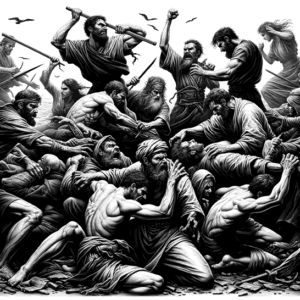 Every story is driven by conflict, and like the transformation, the conflict has to be authentic—meaningful. If your character is going out and just can’t decide what to wear, well … boo hoo. We all have conflicts of our own to deal with and somebody’s wardrobe struggles are just not going to make us care.
Every story is driven by conflict, and like the transformation, the conflict has to be authentic—meaningful. If your character is going out and just can’t decide what to wear, well … boo hoo. We all have conflicts of our own to deal with and somebody’s wardrobe struggles are just not going to make us care.
Remember: Authenticity relates to survival-level challenges: food, love, shelter, sex, status, safety, family, community, etc.
So why do we define the conflict after the transformation? Isn’t that backward?
Yes … on purpose. Stories move from authentic conflict to authentic transformation. To get where we’re going, we have to know where we’re going.
Sometimes, you might get away with starting a story and not knowing how it will resolve, but if you have a 4500-word speech to deliver, your writing will be more focused and will require far-less editing if you decide what your message is ahead of time. Rambling about a topic—even if you’re an expert—is not the best way to serve your audience.
Now that we know where we’re going, we can think about why our audience should care about getting there. It could be that we have a solution to offer for a problem they don’t even realize they have. In fact, the conflict could be that they don’t even know they have a problem! Maybe they think the problem is something other than what it actually is.
Sometimes people think a symptom is a problem. High employee turnover is a symptom, not a problem, but if the audience is blaming millennial values or the HR department, they can’t address the real problem—which is workplace culture.
Ask yourself, “Why can’t the protagonist get to the transformation? What’s stopping them? External obstacles? Internal obstacles? That’s where you’ll find your conflict.
What is your protagonist’s conflict?
The man character in your story is prevented from achieving a goal. What is holding them back?
Luke has work to do on the farm. He doesn’t have time to rescue princesses.
Ahab has to find the white whale first, and then kill it—no easy task. Meanwhile, he;s consumed by his lust for vengeance.
A speaker wishes to overcome their stage fright and grow their confidence.
What is your audience’s conflict?
For the story to capture the audience’s attention, the protagonist’s journey has to be a metaphor for the audience’s journey. Whether they’re aware of it or not, what are the people in the audience struggling with?
People in the audience are afraid to stand up for what is right.
People in the audience need to let go of their anger so they can move on.
People in the audience are afraid to express themselves for fear of being rejected.
Steps on the Journey
 Now that you have defined a destination for your protagonist’s journey and a reason for them to take it, it’s time to map out the journey.
Now that you have defined a destination for your protagonist’s journey and a reason for them to take it, it’s time to map out the journey.
Choose a story type:
Dramatic stories involve elements like “The teacher appears,” “sidekicks” and “wards,” “the darkness before the dawn,” and “the triumphant return.”
Some stories are more “functional.” When Ed (the protagonist) has failed to impress Maria (the conflict) and he wants her to love him (the transformation), he decides that her stomach is the best way to her heart. Choose functional if you want one section for bread, one for peanut butter, and another for jelly instead of all the “Hero’s Journey” stuff.
Will your story be written or spoken aloud?
This impacts language choice: dialogue tags, delivery dynamics, etc.
How long will your story be?
If you’re creating a written work, the word count will constrain your work in a way that’s analogous to speech duration.
Above the steps are adjustable fields for word count, duration, and speed. Duration and speed can be hidden if you’re creating a written piece.
☞Map it!☜
Fill in the steps, keys, or guideposts you share in your story. What do the letters in your acronym stand for? Leave fields blank if you don’t need all of them.
What’s the first step, cornerstone, guidepost, or foundational principle?
A great peanut butter sandwich requires fresh-baked artisan bread.
What’s the next step, cornerstone, guidepost, or foundational principle?
A great peanut butter sandwich requires organic, crunchy, hand-ground peanut butter.
What’s the next step, cornerstone, guidepost, or foundational principle?
A great peanut butter sandwich requires organic, grape jelly.
What’s the next step, cornerstone, guidepost, or foundational principle?
A great peanut butter sandwich should be served immediately after preparation.
What’s the next step, cornerstone, guidepost, or foundational principle?
A great peanut butter sandwich should be served with fine red wine.
What’s the next step, cornerstone, guidepost, or foundational principle?
A great peanut butter sandwich tastes even better with live violin music.
What’s the next step, cornerstone, guidepost, or foundational principle?
A great peanut butter sandwich tastes even better with live violin music.
What’s the next step, cornerstone, guidepost, or foundational principle?
A great peanut butter sandwich confers high social status on the person who serves it, especially as a romantic overture.
What’s the next step, cornerstone, guidepost, or foundational principle?
A great peanut butter sandwich represents the pinnacle of sophisticated culinary culture.
Share the Treasure Map
Transformation is important, even in functional stories. Tell your audience what to do and why they should do it.
Ed has been happily married to Maria for many years, and they’ve raised a brood of healthy, successful children on nothing but peanut butter and jelly sandwiches. Rethink your opinions on this underappreciated gustatory delight. Source fine ingredients, hire a good violinist, and enjoy the sweet crunch of the good life as your dreams magically come true.
Characters
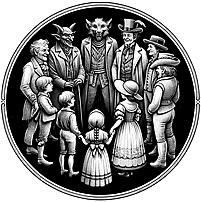
Enter the names and descriptions of your story’s characters in this tab.
Use the various character types to inspire your thinking about the people your protagonist encounters on their journey. Fill in only the boxes that apply to your story. Simple, practical stories may involve only a hero and a villain while epic, dramatic stories may involve a large cast of characters.
Don’t take the mythical roles too seriously. Consider that “your mother” might play the role of a villain in the story because when you were six, her refusal to take you to the playground made you think of her as “evil.”
Use the “Additional Characters” box at the bottom of the tab to describe any other characters.
Character Avatars
Principal character who embarks on a journey from conflict to transformation.
Elian is a brave young villager with a heart full of dreams who is destined to discover his true strength.
The antagonist who sets obstacles in the hero’s path, embodying conflict and opposition.
Lord Vexor is a dark sorcerer whose shadow looms over Eloria.
The wise guide who shows the protagonist the way.
Mira is an elder who teaches Elian the secrets of the Crystal of Light.
A faithful companion who provides support, humor, and camaraderie.
Tibalt was turned into a mischievous fox by Lord Vexor. He is always ready with a witty quip or a clever plan.
A character contrasting the hero who highlights particular qualities or flaws.
Sir Gavin is a boastful knight whose arrogance only serves to underline Elian’s humility.
A guardian who protects a person, place, or object. The protagonist must appease, kill, or bypass the gatekeeper to pass to the next step of the story.
The Stone Sentinel, guardian of the ancient bridge, tests Elian’s wisdom and courage.
An unpredictable character who changes loyalties or appearances. A master of adaptation who changes to fit into different situations and environments.
Luna is an enigmatic traveler whose allegiance and form shift as the moon’s phases.
The dark reflection of the hero, embodying fears or repressed desires. This can be a character or the voice of the protagonist’s doubts and fears.
Elian’s inner voice whispers his fears of inadequacy and failure.
A character who announces the change that calls the protagonist to make the journey.
A mysterious crow delivers the prophecy of Elian’s destiny to unite Eloria against the darkness.
A playful or mischievous character who challenges norms and causes chaos.
Finn, a silver-tongued merchant who delights in riddles and double meanings, leads Elian on a merry chase.
A character who has been banished or chooses to live outside society’s norms.
Zara is a lone warrior exiled for challenging the corrupt elders. He finds a kindred spirit in Elian.
The embodiment of wisdom and insight who provides deep knowledge and perspective. The sage differs from the mentor or teacher in that they usually do not accompany the protagonist on their journey.
Old Bramble, the forest hermit offers riddles that reveal the path to inner strength and enlightenment.
A challenger of authority and status quo, who is driven by a desire for change or justice.
The Crimson Band, a group of rebels fighting Lord Vexor’s tyranny, are led by the fearless Rowan.
A resilient fighter who overcomes great odds and personal tragedies.
Ella, the village healer, saved countless lives during the furst rebellion.
A restorer of health, balance, or harmony, who offers physical or emotional recovery.
Sister Althea, the monastery’s head, offers potions and wisdom that mend physical wounds and troubled hearts.
A bringer of laughter and lightness who uses humor to reveal truths and ease tensions.
Jinks is the court jester whose jests and jibes conceal wise observations about court and commoner alike.
A curious and adventurous character who seeks new horizons and experiences.
Captain Nell is a daring sea captain whose tales of unknown seas inspire Elian to look beyond the horizon.
A competitor who may be similar to the hero but differs in methods or morality.
Darius seeks the Crystal of Light and the fall of Lord Nexor to achieve power, not peace.
The embodiment of fear and an obstacle that must be defeated by the hero.
The Gloombeast, a cruel and powerful creature, blocks the path to the Crystal’s sanctuary.
A self-sacrificing character who puts others or a cause above themselves.
Kael, the knight who sacrifices himself to save Elian and his companions from a deadly trap.
A naive or pure character who is untouched by the world’s darkness.
Lily is a young child who has no knowledge of Lord Nexor’s cruelty and the danger she is in.
A loner who seeks love, connection, or a place to belong.
Orin is a street urchin whose cunning and courage earn him a place among Elian’s companions.
A wielder of metaphysical power and manipulator of reality.
The Alchemist Verid creates potions that alter reality and offer Elian unexpected assistance.
An alluring or seductive character who attempts to distract the hero away from their path.
Seraphine, the enchantress creates illusions that tempt Elian away from his quest, and test his resolve.
A fighter who embodies courage and discipline in battle.
General Thorne was the leader of the first rebellion. His strategies and valor turn the tide against Vexor’s forces.
A bearer of good or bad news who alters the course of the journey.
A silent dove arrives with news of Lord Vexor’s latest move, setting Elian on a race against time.
A character driven by need, greed, or resentment who steals.
The Shadowhand is a notorious thief whose latest heist uncovers a secret crucial to Elian’s quest.
A character in need of help who the protagonist feels obliged to invite to join the journey, even though they are a burden.
Myra, a gifted seer, is fragile, defenseless, and haunted by visions. Elian knows she will perish if he doesn’t take her with him, and her insights turn out to be vital to navigating the dangers ahead.
This character can be male or female. They are unjustly imprisoned, in grave danger, and they may hold the key to resolving the story’s conflict.
Prince Alden is held captive in Vexor’s tower. His knowledge of the Crystal’s location is key to its recovery.
Describe any additional character or characters and their roles here.
Create Your Story!
If your story is short, the Wizard will generate a first draft. If it’s longer, the Wizard will create a summary that will help you map out the final, authentic journey from conflict to transformation—for your characters and for your audience!
Do you have a “phrase that pays?”
One more question: A “phrase that pays” is a lesson wrapped up in a tidy statement. Or it could just be a repeated phrase (anaphora) that gives the work a unique quality. Enter your Phrase that Pays or leave the box blank if you don’t have one.
I should have expected that!
I have a dream!
That’s not how my story was supposed to go!
Already have access? Log in here.

























